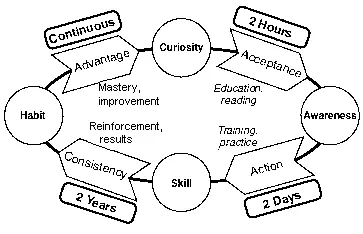Rick Page - Make Winning a Habit [с таблицами]
- Название:Make Winning a Habit [с таблицами]
- Автор:
- Жанр:
- Издательство:неизвестно
- Год:неизвестен
- ISBN:нет данных
- Рейтинг:
- Избранное:Добавить в избранное
-
Отзывы:
-
Ваша оценка:
Rick Page - Make Winning a Habit [с таблицами] краткое содержание
A master of the complex sale and a bestselling author, Rick Page is also one of the most experienced sales consultants and trainers in the world. Make Winning A Habit defines the gap between what companies know to do and how they consistently perform.
Page clearly identifies five “Ts” of transformation: Talent, Technique, Teamwork, Technology and Trust. These five elements, when fully developed and integrated into the sales and marketing organization, begin to create the habit of winning over customers in every industry. Stories of successes-and failures-from members of prominent companies help you apply the five “Ts” to your company's culture, and point the way to more effective plans for motivating employees, building and coaching winning teams, and improving hiring processes.
Then, with the use of Page's assessment scorecard, you can compare your company with some of the strategies and practices of the best sales forces in the world. Designed to gauge your organization's effectiveness and further develop breakthrough sales growth, this scorecard highlights your strengths and weaknesses, helping you bridge the gap between where you are and where you need to be.
You'll also learn about:
The “Deadly Dozen” (pains sales managers feel today) and how they can kill business
A ten-point process for identifying and hiring nothing less than “A” players
The 8 “ates” of managing strategic accounts and how they will maximize revenue and elevate relationships
How to identify and correct the six most common areas of poor individual sales performance
With Make Winning A Habit, you'll discover the obstacles between you and the consistent sales performance you can achieve-and find the tools to not only make success a habit, but one that will keep growing with your business.
Make Winning a Habit [с таблицами] - читать онлайн бесплатно полную версию (весь текст целиком)
Интервал:
Закладка:
Over the past 30 years I’ve had a lot of managers come to me looking for improvement. Some of them are ready to make drastic changes and are willing to do whatever it takes to solve their business problems. Others aren’t comfortable with that much change. They want improvement but not transformation. Others just want a speech. Some want a miracle.
To achieve true competitive advantage, obviously there has to be a lasting top-management commitment to full integration of all sales processes from hiring to training to compensation to team roles and responsibilities, rewards, and performance. To really make it stick, managers have to get back into both deal coaching and performance coaching.
I would start by requiring every manager to read Larry
Bossidy and Ram Charan’s excellent book, Execution, the Discipline of Getting Things Done. It focuses on what it takes to build a culture of execution in all areas. One of my favorite quotes from the book is, “Coaching is the single most important part of expanding others capabilities. It’s the difference between giving orders and teaching people how to get things done. Good leaders regard every encounter as an opportunity to coach.”
The key is integrating these new processes, embedding them in every aspect of your culture from management language to forecasting, the sales cycle, and compensation.
Before you can transform your sales force, you have to understand how adults learn. In addition, salespeople learn differently from other adults. In our experience, there are four steps: curiosity, awareness, skill, and habit (see Figure 9–1).

Curiosity
Curiosity is the seed of learning — the individual has to bring this to the table. In our sessions, we always have a mixture of sponges, vacationers, and prisoners. The first two hours are spent getting the prisoners to unfold their arms. They are prisoners of their own experience.
We have to create a gap between where they are and where they need to be to survive and thrive as the demands of selling and the buyer evolve. They need to understand that they must either grow or go.
Awareness
New awareness is important to personal growth. Reading and training are essential. By definition, a system cannot change itself from within. It takes outside forces. But you can’t get competitive advantage from awareness alone. It comes from speed of reaction and execution.
For many people, personal growth and development after college often stagnate or are limited to gaining the skills and knowledge needed to perform their current job. For salespeople, however, the competencies required to perform in today’s market have escalated because they now need to sell to all levels of their client organizations.
Whether a salesperson is a vice president or not, they need to be conversant with and knowledgeable about Clevel issues. However, many salespeople have not developed the necessary strategic literacy in their industries.
Skill
I play golf often and have some skills. I’ve read almost every book on golf, so I have awareness. I birdie some, par some, and have eagled a few. But Tiger Woods does consistently what I do occasionally (I know, he does some things I’ll never do) because he has the discipline to practice incessantly — with his coach — to develop his superior natural physical talents (which I will never have) to their fullest potential. Without this discipline, though, he might be just another trunk slammer, fighting to stay on the tour.
This is also the difference between best-in-class sales organizations and the rest of the pack. The leading sales forces do consistently what others do only some of the time. In the complex sale, the stakes are huge, and the difference between the winner and the loser is often a very close margin.
Habit
Competitive advantage comes with making skills a habit — a permanent, consistent behavioral change at the individual and organizational levels. From awareness to habit is really a two-year process of guided practice.
During the first year, you’re telling them. During the second year, you’re making them realize that this isn’t just the “theme of the month” and that it’s here to stay.
Sometimes salespeople decide to just wait a year until the sales manager either gets fired, taking his new processes with him, or fails to follow up. It will take two years of consistent pressure on your part before all your salespeople are finally convinced that the new process is here to stay.
They will begin to get on board when they see others winning using the process. They will make it a personal habit when the company makes it an organizational habit. Every time you don’t insist on an activity, strategy session, sales plan, principle, or standard, the cloth of discipline begins to tear.
Greatness can be nothing unless it’s lasting.
Napoléon BonaparteAn equal challenge is how to make such a process or technology stick with salespeople, who have short attention spans and would rather talk than write. Sales forces have stared down implementations and used passive resistance to outlast scores of multi-million dollar CRM and training initiatives.
Formula for Failure — What Won’t Work
• Declare that, “We have a sales problem.”
• Implement CRM as a fix.
• Hire a big consulting firm to define your sales cycle (be sure to spend seven figures and take a year). Display the results in a large binder.
• Buy what looks or feels good or what came with your new CRM system.
• Pay less than competitive rates to recruiters.
• Make the form or CRM input very comprehensive (i.e., long), and ask everyone for input.
• Run your training at your sales meeting; make sure that it’s the first time your managers have seen it.
• Train your own trainers to save money.
• Hope for adoption, make threats, use guilt, and cheerlead for results.
• Use revenue as the only metric.
• Excuse veterans from compliance.
Management Commitment: They’re Watching You to See If You Are Still Watching Them
This is obvious, of course, but what does it mean? Beyond the customary announcements of top management, it means consistency of execution. Busy salespeople will wait to see if this is just another “theme of the month.”
It may seem unnecessary to emphasize that managers must actually attend and help to lead training sessions, but we have seen organizations where this expectation clearly was not set. Every salesperson is watching his or her manager during any rollout for body language, faint praise, passive resistance, or cynicism.
Every failure by management to reinforce the process will cause the fabric of discipline to begin to tear and competitive advantage to slip away. I once passed one of my managers in the hall and asked him about an action item we had agreed on months earlier. He said, “You don’t forget about these things, do you?” It was one of the best management compliments I ever received.
Fortunately, the new Web-based tools allow managers to see who is actually using the process on a daily basis. The Fort Hill Company, founded by Cal Wick, has built software so that managers can track action item completion and training follow-through by individual, complete with dashboard and graphics.
“You need to check-up periodically and let them know that you are looking. A quick e-mail or some online feedback will put them on notice that you are checking and that you expect execution,” Wick says.
According to Wick:
Up until now, most training programs concentrated exclusively on what happened in the classroom. What happened afterwards was a “black hole.” In fact, what usually happened was something like this: Sales training put on a course to teach new skills and approaches to optimizing the sales process. In the concluding session, attendees were asked to write a goal for applying what they had just learned. They did. Then they put it in their notebooks, put the notebook on the shelf, and went back to doing what they had done before.
Technology is changing that.
As with the other technologies we discuss, a followthrough system alone is not a solution. To maximize the value of follow-through management technologies, managers and training professionals need to pay attention to what is going on. They need to use the system to track behavior and provide encouragement, recognition, or correction as necessary.
When that is done, postcourse follow-through technology increases the impact of sales training and the value companies realize as a result.
Moreover, adoption needs to be incorporated into comp plans and performance reviews of all managers for it to really stick.
One of Cal’s clients, AstraZeneca wanted to increase the amount of coaching its sales managers did, so it ran a program called “Breakthrough Coaching” but did nothing to ensure that managers followed up on what they had learned. Not surprisingly, not much changed in the field.
So the company went back to the drawing board and developed “Breakthrough Coaching II.” The big difference this time was that the company put a rigorous system of follow-through in place to make sure that what was taught was used.
Every manager who attended the program was required (1) to set two goals for improving their coaching and (2) to report on progress five times over a 10-week period. Area and regional managers had access to the follow-through technology so that they could see who was doing what they were asked and who was getting results.
The change was dramatic. Salespeople were polled three months after their managers had attended the program.
• 48 percent reported increased frequency of coaching interactions with their managers.
• 59 percent experienced a shift to a more coaching style of interaction.
• 61 percent felt that their managers were more effective or much more effective as a result.
One summed it up this way: “I am now receiving coaching even when the situation is positive. I used to feel like I only received coaching when I needed to improve on something. I feel like my manager is more in touch with what I am doing.”
If you want something to stick, you have to make sure that it is reinforced. The real work begins when the course ends.
It Takes One to Two Years — Do You Have That Long?
Our first step as managers is to expand our time focus. For an individual, research shows that it takes about 21 days to form a habit. For an organization, it takes one to two years of consistent and persistent reinforcement to create organizational habits.
You can get awareness in two hours through a book or a speech. You can start to build skills in a two-day training program. But it may take two years for your salespeople to figure out that you’re going to stay with this and for them to actually see the results when they use it versus when they don’t.
Real World and Relevant
A successful class alone will not ensure adoption. But a bad one will ensure failure. Word of mouth on the first class will make or break the effort.
The first step toward making a new process stick is to make the training relevant. Canned programs won’t work anymore. The best training actually involves working live deals in class. Similarly, in technology rollouts, salespeople have to see how it helps them with their everyday jobs.
Читать дальшеИнтервал:
Закладка:
![Обложка книги Rick Page - Make Winning a Habit [с таблицами]](/images/nocover.webp)


![Сергей Снегов - Язык, который ненавидит [с иллюстрациями и текстовыми таблицами]](/books/1097573/sergej-snegov-yazyk-kotoryj-nenavidit-s-illyustrac.webp)




